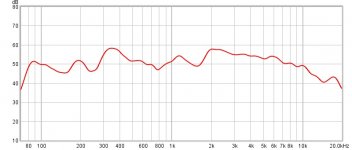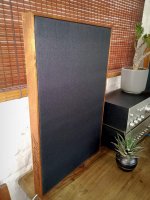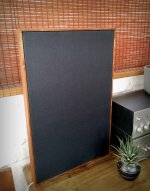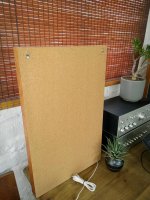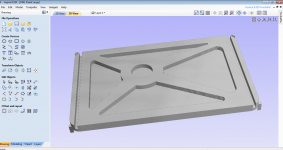My first test pair done...
Hi all,
It's been a while but I've finally managed to finish my first test pair. They are small'ish carved XPS panels (350mm X 560mm) suspended within a hardwood frame, polyfill and cork backed because I want them to be wall mounted.
They sound very good paired with a small subwoofer but they did lose a tiny bit of magic when I closed up the back.
Attached is just a few quick pics and a REW measurement.
........on to the next panels 😀
Hi all,
It's been a while but I've finally managed to finish my first test pair. They are small'ish carved XPS panels (350mm X 560mm) suspended within a hardwood frame, polyfill and cork backed because I want them to be wall mounted.
They sound very good paired with a small subwoofer but they did lose a tiny bit of magic when I closed up the back.
Attached is just a few quick pics and a REW measurement.
........on to the next panels 😀
Attachments
Jmatt,
Those look great. Is the REW measurement with the back on or off, and what is the suspension method for the XPS panel within the frame?
Those look great. Is the REW measurement with the back on or off, and what is the suspension method for the XPS panel within the frame?
Jmatt,
Those look great. Is the REW measurement with the back on or off, and what is the suspension method for the XPS panel within the frame?
Thank you, the measurement is with the back on. The panel is suspended by a bead of silicone on top and bottom tabs.
Attachments
Hi all,
It's been a while but I've finally managed to finish my first test pair. They are small'ish carved XPS panels (350mm X 560mm) suspended within a hardwood frame, polyfill and cork backed because I want them to be wall mounted.
They sound very good paired with a small subwoofer but they did lose a tiny bit of magic when I closed up the back.
Attached is just a few quick pics and a REW measurement.
........on to the next panels 😀
Here are 2 tips.
1. you could of left the back open and put 1-2inch spacers (with foam) to get some of that bipolar magic back.
2. If the wood frame is touching the wall it will vibrate the wall so some type of foam damping can be used in the back on each corner.
Also is that Grill cloth? If so you are the first person that I've seen (besides myself) use grill cloth. Grill cloth can help in taming the sound of the panels making them sound less harsh.
Last edited:
@JMatt - great looking panels and the measurements looks good too.
JMatt's panels certainly looks great with the grill cloth. I assume that grill cloth does not dampen the panels as much as canvas (OffGridKindaGuy's panels). DMLBES - do you actually glue the grill cloth to the panels?Grill cloth can help in taming the sound of the panels making them sound less harsh.
@JMatt - great looking panels and the measurements looks good too.
JMatt's panels certainly looks great with the grill cloth. I assume that grill cloth does not dampen the panels as much as canvas (OffGridKindaGuy's panels). DMLBES - do you actually glue the grill cloth to the panels?
Yes you are correct, grill cloth has WAY less dampening properties then canvas.
I just make framed grill cloth covers like most conventional boxed speakers use. You can glue the cloth directly to the panels but like I said before any adhesive you use can add more damping. Other options is to glue it to the panels frame. You can also make a sock like wrap around cloth cover used in (bipolar) speakers like Def Tech, Mirage, etc.
Hi,
I am getting confuse over the terms used describing DML speakers being bipolar?
If one says the speaker is bipolar then both the front surface and back surface have to be 180 degrees in or out of phase. How does the audio exciter accomplish this if the exciter is moving forward the front surface is generating a compression wave and the back surface is generating a reification wave is this not a dipole like a magnapan or electrostatic speaker? How do you move the front and back surface in opposite direction at the same time with one exciter?
I am getting confuse over the terms used describing DML speakers being bipolar?
If one says the speaker is bipolar then both the front surface and back surface have to be 180 degrees in or out of phase. How does the audio exciter accomplish this if the exciter is moving forward the front surface is generating a compression wave and the back surface is generating a reification wave is this not a dipole like a magnapan or electrostatic speaker? How do you move the front and back surface in opposite direction at the same time with one exciter?
Hi,
I am getting confuse over the terms used describing DML speakers being bipolar?
If one says the speaker is bipolar then both the front surface and back surface have to be 180 degrees in or out of phase. How does the audio exciter accomplish this if the exciter is moving forward the front surface is generating a compression wave and the back surface is generating a reification wave is this not a dipole like a magnapan or electrostatic speaker? How do you move the front and back surface in opposite direction at the same time with one exciter?
Bipole= sound radiates from the front and the back equally.
Dipole=out of phase.
Not to be argumentative but from what the literature is showing is a dipole have equal polar lobes but they are 180 degrees out of phase. The bipole has equal polar lobes just as a dipole but the lobes are in phase. So to create a bi pole speaker one would need two exciters that were on opposite side and wired opposite so that each side would be in phase or bipole. For panels that are driven by exciters on one side it would have to be a dipole and the side with the exciter would have a higher SPL than the opposing side since there would be attenuation going through the panel.
Tagis, you're correct. DMLBES is not. The DML is chaotic, it isn't phase coherent so it is not a bipole in the acoustic sense.Not to be argumentative but from what the literature is showing is a dipole have equal polar lobes but they are 180 degrees out of phase. The bipole has equal polar lobes just as a dipole but the lobes are in phase. So to create a bi pole speaker one would need two exciters that were on opposite side and wired opposite so that each side would be in phase or bipole. For panels that are driven by exciters on one side it would have to be a dipole and the side with the exciter would have a higher SPL than the opposing side since there would be attenuation going through the panel.
Tagis, you're correct. DMLBES is not. The DML is chaotic, it isn't phase coherent so it is not a bipole in the acoustic sense.
Are you sure about that? Tell me why he is correct and I am wrong? You just a troll want to start shiznit instead of trying to solve the problem with nothing to offer as usual. LOL
Even your Buddy Burnt says they are Bipolar. SMDH
On bass cancellation DML’s are bipoles not dipoles so there is no front/back cancellation. I was getting down to 50hz on a cheapo spectrum analyser App but hearing deeper if you see what I mean. I am now running subs from 100hz down and to my surprise they integrate much better than I thought they would. The bass appears to be coming from the panels untill I stand really close to the sub.
Last edited:
There's plenty of published stuff on DMLs about the chaotic nature of their radiation.Are you sure about that? Tell me why he is correct and I am wrong? You just a troll want to start shiznit instead of trying to solve the problem with nothing to offer as usual. LOL
Even your Buddy Burnt says they are Bipolar. SMDH
A bipolar is classically demonstrated by two moving coil drivers, one front, one back, both radiating in phase. Ie they both push or pull at the same time.
A dipole on the other hand can be as little as one driver on an open baffle. Front and back radiation in opposing phase. Front pushes while rear pulls.
The DML panel is excited by a random chaotic pattern of vibration. It is a completely different mode of operation.
Clearly whatever one side of the panel is doing, the other side will be doing the opposite, as the panel retains its thickness while vibrating. It behaves like a dipole at all points. At a low enough frequency it behaves as one large dipole. What it does, as a whole, at other frequencies I don't know.
Last edited:
There's plenty of published stuff on DMLs about the chaotic nature of their radiation.
A bipolar is classically demonstrated by two moving coil drivers, one front, one back, both radiating in phase. Ie they both push or pull at the same time.
A dipole on the other hand can be as little as one driver on an open baffle. Front and back radiation in opposing phase. Front pushes while rear pulls.
The DML panel is excited by a random chaotic pattern of vibration. It is a completely different mode of operation.
There are plenty of published stuff on DML's being bipolar just ask Burnt. lol
NO ****, that's what I said. Bipolar means sound is radiated from the front and back equally. Which means they are in phase. SMDH
Dipole means out of phase. SMDH
Tagis said they are dipoles.
You are saying they are neither. What mode of operation are they? and please don't say chaotic. LMAO
THis is what Burnt wrote>
I have read that DML’s are bipole rather than dipole.
From an article by Peter Mapp on of the original developers from this site SoundRight - Peter Mapp
“The acoustic power output radiated from the back sums non-destructively with the sound from the front instead of cancelling. This is attributable to the complexity of the distributed modal radiation and uncorrelated phase of the individual radiating elements as seen from the far field.”
And
“DML loudspeakers, although inherently bipolar, can be enclosed. The enclosure can be shallow (approximately 2 inches or 51 mm), and so a low profile loudspeaker can still result. Enclosing a panel changes the bipolar directivity pattern to wide dispersion forward radiation, but the diffuse nature of the radiation is maintained. Also, by enclosing the panel in a known way, the response can be optimized, and the unit can then be wall or boundary mounted with only minimal acoustic effect.”
Clearly whatever one side of the panel is doing, the other side will be doing the opposite, as the panel retains its thickness while vibrating. It behaves like a dipole at all points. At a low enough frequency it behaves as one large dipole. What it does, as a whole, at other frequencies I don't know.
WTH? So at low frequencies they are dipole but at other frequencies as a whole you don't know? SMDH that is far from being clear. LOL
Peter Mapp is saying that the sound is somewhat bipolar at far field. It's not surprising that the response is complicated. It depends on the modal response of the panel to the exciter, the coupling of the panel with the air, and the final result of that at listening distance.The acoustic power output radiated from the back sums non-destructively with the sound from the front instead of cancelling. This is attributable to the complexity of the distributed modal radiation and uncorrelated phase of the individual radiating elements as seen from the far field
This looks quite "not-quite-dipolar chaos" to me, but then again I do not know what I'm talking about. 🙂
An externally hosted image should be here but it was not working when we last tested it.
Peter Mapp is saying that the sound is somewhat bipolar at far field. It's not surprising that the response is complicated. It depends on the modal response of the panel to the exciter, the coupling of the panel with the air, and the final result of that at listening distance.
Its either Bipolar or its not.
- Home
- Loudspeakers
- Full Range
- A Study of DMLs as a Full Range Speaker
